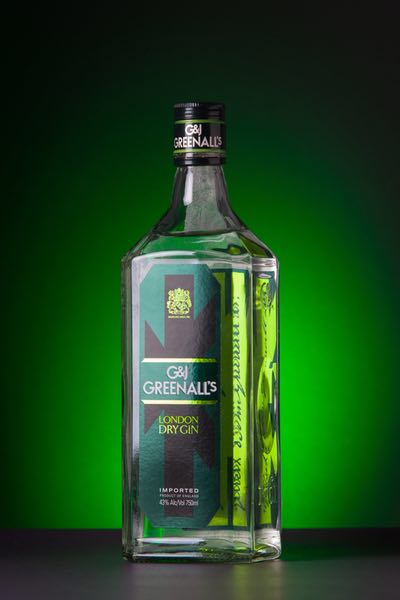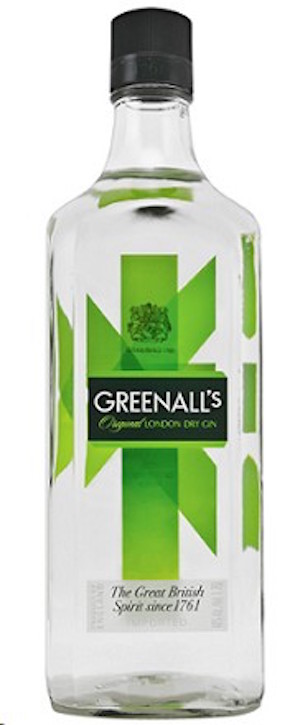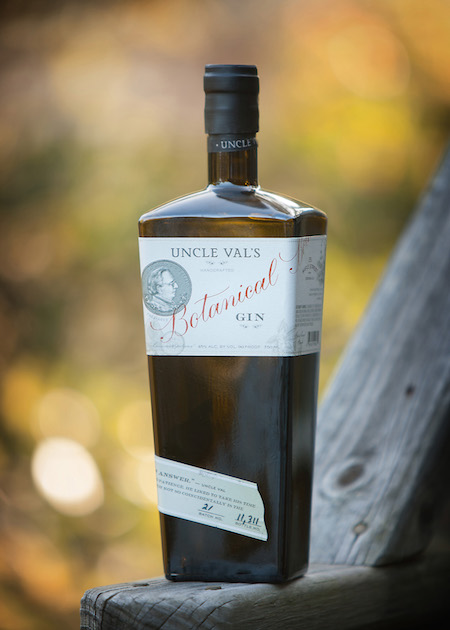Greenall’s London Dry Gin
Brand: Greenall’s
Style: London Dry
Distillery: G&J Distillery, Warrington, United Kingdom
ALC: 40%/80 proof
Average US Retail Price: $19-$22/750 ml
Website: http://www.greenallsgin.com/
Russ’s Review
It’s time to stake out our biases and a review of Greenall’s London Dry Gin is one the best places to start.
Heck, it claims to be the first gin ever made in the London Dry style–operating from the oldest operating distillery in merry old England since 1761.

Photo Note: This was a bitch to shoot. The label’s colors don’t reflect a lot of light directly back at you when you are looking at it. Some graphic designer having fun with camouflage is my guess. To really see it, light has to skim across the label from a side angle. Meeting that challenge was most satisfying. Wish the gin was as well.)
For folks like your humble authors who are working on their sixth- decade- of- life gold star, the number of gin brands out there was minimal.
To make matters more difficult, both of us have spent a considerable amount of time in Southern states of the U.S., of late North Carolina, where the state government holds a monopoly on and is the sole distributor of “spirited” alcohol.
Greenall’s is not widely available in the southern United States, in liquor stores or bars and taverns–at this is the part of the U.S. where your two humble scribes have spent much of lives.
So those of who turned on to gin were definitely influenced by the juniper forward flavors of Boodle’s, Tanqueray and the pre-Sapphire version of Bombay–the stuff mostly available in most state-owned liquor stores–common in many Southern states.
Enter Greenall’s and my tasting notes.
Au Natural-pour an ounce into a shot glass. Sniff.
I didn’t notice any of the usual harsh alcohol notes. But the juniper was there and so was a hint of citrus—not quite orange but damn close.
Now, throw that sucker back, tequila shot style and my bet is you’ll experience a very smooth entry, similar to this gin-Bristol Bay (http://gingents.com/?p=29) with the juniper slightly, but noticeably present.
On the rocks it came across super as super smooth, but now the juniper and other botanicals begin to migrate to the backseat.
For the gin and tonic I reverted to one of the two standard American grocery store tonics—in this case Canada Dry with a squeezed lime wedge.
In this traditional drink, Greenall’s cannot stand up to the sweetness of the typical tonic. It migrated to the trunk!
While not a total loss—there is barely a hint of gin and juniper in there—(I used 2 parts gin to 4 parts tonic), in this format there are other gins than can hold their own against tonic mixes.
Last, but not least, I went with my least favorite gin drink-the martini.
Two shots were added into a shaker populated by ice.
A few vigorous shakes and then I poured the Greenall’s into a martini glass.
What came next was an epiphany of sorts.
I have slowly come to accept gin on the rocks and and the gin martini—either in its pure form or with a minimal amount of olive juice and an olive garnish (never with vermouth), but I still tend to prefer gins where the traditional botanicals are out in front.
Whereas Bristol Bay (http://gingents.com/?p=29) as a martini came across as smooth— it displayed very few gin characteristics.
Greenall’s presented as a mild gin with hints of juniper, pepper, and citrus in the martini form.
Thus, reserving the right to adjust my reviews as we sample more gins, I would highly recommend Greenall’s over Bristol Bay as a bridge for those looking to cross over from vodka to gin martinis.
However, if you prefer gimlets or gin and tonics you might want to pass on this one, although it’s awfully refreshing on a hot summer day.
Verdict-well worth the try for newcomers to gin and especially gin martinis. The price is right, the gin essentials are there, if muted, and you won’t miss your vodka martini anymore.
Jim’s Review
Tasted: September 7, 2014 & November 7, 2014
Review and Photo by Jim Trotman
Tamarind paste, mango, sourdough bread, and butter.
I’m happy to report these are tastes and smells you will NOT find in G&J Greenall’s gin.
We’d had a run there of American style gins and I was getting fully psyched to encounter such inharmonious and damn near blasphemous ingredients in the next sampling for Gin Gents. I was thrilled and elated even when Russ brought us back to basics with the choice of an attractive London Dry for our next tasting.
Here it was; a crisp green bottle, it’s logo an adaptation of the England’s Union Jack, plus there’s a family crest boasting a distilling heritage from 1761. Finger wells in the sides of the bottle aid in the grip and there’s the date again, in glass relief. It’s got London Dry in its veins. And yet…
A small serving, neat, revealed alcohol. Duh. That was about it. Straight up isn’t a thing I normally do unless I’m familiar with the spirit, so I went to rocks. Yes, there was juniper in there by gosh, but only a signal hint of it. A wee bit of citrus that only came on when chilled. Finish was slightly peppery.
So we got back to juniper, however faintly, but something in there was bringing a vague sweetness. Not so dry as maybe dry should be. Where was I going?
I brought some tonic on board and things got smoothed out. Smooth to the point of it basically being an alcohol tasting tonic. Where was the “Umph” factor? Maybe they didn’t see a need any umph back in 1761. After wandering the fruity American Plains there had to be something in G&J’s I could get into.
Now this is a drinkable gin. There wasn’t anything that leapt out to me that was off-putting. As standard gins go, this wasn’t awful, like that Aristocrat swill. But it did leave me a little disappointed. I suppose I should put that on me and my own goofy expectations. My notes tell me that I would drink this again, but it would be a hard sell as a martini. I’m going with that. I was searching for character, something to hang my hat on with this gin. I just had trouble finding it.
(Photo Note: This was a bitch to shoot. The label’s colors don’t reflect a lot of light directly back at you when you are looking at it. Some graphic designer having fun with camouflage is my guess. To really see it, light has to skim across the label from a side angle. Meeting that challenge was most satisfying. Wish the gin was as well.)









